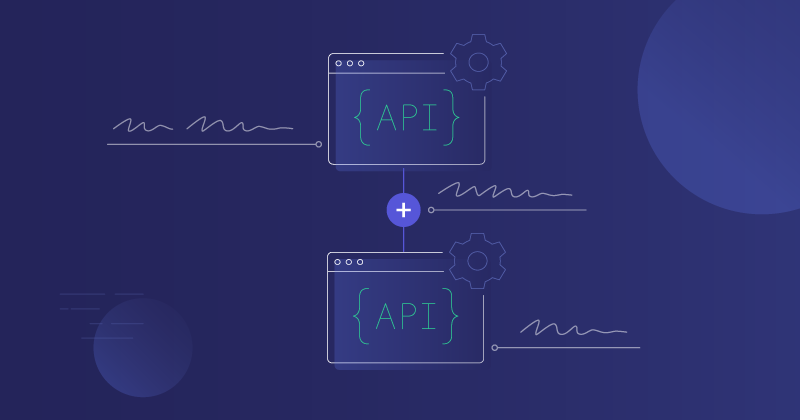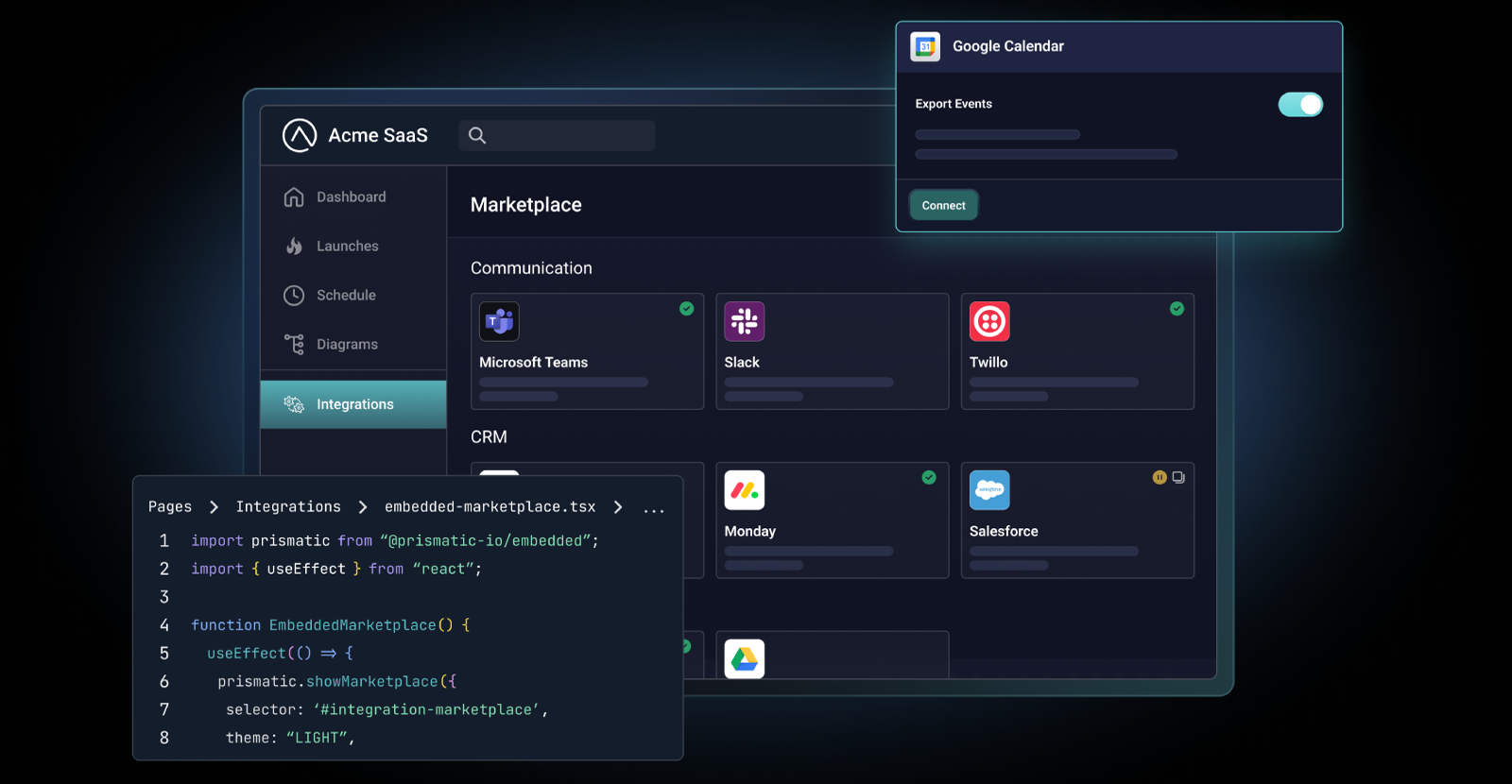You've built a SaaS app. You know your customers need integrations to connect your app with all the other apps they use. And building integrations can be a time and resource-intensive task.
What have other teams done? Some have gone ahead with the traditional approach: building integrations in-house. But an increasing number are using an API integration platform from a third party to deploy native integrations. These API integration platforms simplify building embedded integrations for B2B SaaS customers.
API development and integration
APIs exist for various purposes. Some APIs are internal to a system and connect subsystems or enable the system's front end to talk with the back end. These APIs are not used for integrations.
Other APIs enable data exchange with integration partners. Developers use these types of APIs to create native integrations.
A native integration extends the app, so users can't tell where the app stops and the integration begins. Native integrations built with third-party tools and then embedded in the app are called embedded integrations.
Characteristics of APIs for integrations
APIs for integrations are set up to send or receive data (or both). One API regularly exports data to an integration or when something changes in the source system. Another API waits for requests from an integration and then exports the requested data. A third API might import data from another through an integration. Or a single API might be set up to import and export data.
What is an example of an API integration method?
API integration methods are usually either pub/sub (publish/subscribe) or query based. Most APIs will use REST, SOAP, or RPC protocols. These protocols govern how data is pushed to or pulled from the API and whether the data is sent as XML, JSON, or another file type.
A native integration with Microsoft's Graph API might enable your app to upload an invoice file to your customer's SharePoint site every time a sales record is created in your app.
A more complex native integration with Salesforce's API might sync account data with your customer's Salesforce and your app. But Salesforce uses XML data, and your app uses JSON data. In addition to sending the account data both ways, you'll need the integration to convert (de-serialize) the XML into JSON when exporting from Salesforce and serialize the JSON into XML when importing to Salesforce.
API integration platforms allow devs to use pre-built connectors to connect with APIs and reduce or eliminate the code they usually write. These connectors work with many common SaaS apps and also handle authentication.
What is an API integration platform?
An API integration platform is a system that allows companies to transfer information between multiple APIs. Each API has its own rules for connecting, auth, querying, etc. An API integration platform enables users to build integrations that follow the rules for each API, thereby automating data exchange.
An enterprise iPaaS is an API integration platform that enables the transfer of data between APIs internal to the workflow of a single company. An embedded iPaaS is an API integration platform that enables data transfer between APIs to support the business workflow of a B2B SaaS company's customers.
What is the best API integration platform?
The short answer? The one that best meets your use case. For B2B SaaS, the best API integration platform is an embedded iPaaS (integration platform as a service). An embedded iPaaS, or embedded integation platform, is a set of tools that enables a SaaS company to quickly build reusable, configurable integrations to any app in any software category and deliver them to its customers as a seamless part of its product.
Should I use an embedded iPaaS for my API integration platform?
An embedded iPaaS can provide you with several advantages over building everything in-house. But is it the right solution for you? Here are some scenarios that are ideal for using an embedded iPaaS:
- You need many integrations.
- Your integrations are complex.
- You need to improve the integration experience for your customers.
You probably don't need an embedded iPaaS if:
- You have a handful of integrations.
- Your integrations aren't complex.
- An integration is the core of what you provide.
What about a traditional iPaaS?
We've been focusing on embedded iPaaS, but we should also mention traditional iPaaS (or enterprise iPaaS). A traditional iPaaS is a general-purpose platform used by businesses to create integrations for internal use. In contrast, an embedded iPaaS is a purpose-built platform used by software companies to create native integrations for their customers.
If you need embedded integrations for B2B SaaS, a traditional iPaaS lacks vital functionality such as customer management and an integration marketplace. Some companies have used an iPaaS for customer integrations, leading to a poor customer integration experience. For more detail, check out our post on why a traditional iPaaS doesn't work for software companies.
How do I know which embedded iPaaS to use?
Here are a few steps you can take to select the right embedded iPaaS for your SaaS app:
- Involve the right stakeholders in your evaluation. Multiple perspectives are key.
- Confirm that the solution supports your big-picture requirements. Will it scale, etc.
- Get a demo early in the process. Nothing like seeing how the product actually works.
- Conduct a realistic proof of concept. Build the next integration in your queue.
- Verify the solution's ability to handle real-world complexity. Can it do what you need?
- Confirm the platform's extensibility and custom connector support. Does it let your devs write needed code?
- Ensure that the solution fits your existing tools and processes. You probably have enough exceptions already.
How much does an API integration cost to build?
API integration costs can vary greatly. Factors that contribute to variability include the following:
- Integration complexity
- Tech partner responsiveness
- Infrastructure availability
- Team members' skill levels
Cost of using the traditional approach for API integrations
You can build API integrations from scratch. We often call this the traditional approach to integrations. Here are the steps to enable native integrations using the traditional approach:
- Build or provide the infrastructure to run them.
- Set up infrastructure and code to handle authentication.
- Surface webhook endpoints, or set up another API connection method.
- Make everything accessible to monitoring and logging platforms.
- Establish a way for your customers to self-serve integrations.
- Do all the above in a secure, reliable, standards-compliant manner.
- Finally, create, test, and deploy the integration.
API integration costs can vary widely when using the traditional approach. A simple API integration might require 1 to 2 months from start to finish, with medium-complexity integrations requiring 3 or 4 months and complex integrations taking anywhere from 6 to 9 months or more. Given the above, simple integrations could start at about $10,000, with complex integrations costing over $100,000.
Cost of using an API integration platform for API integrations
You can also build API integrations with an API integration platform – specifically an embedded iPaaS. This approach to integrations takes quite a bit less time and effort because the platform includes tools and code which allow developers (and non-developers) to write much less code.
If we look at the items from the list we just used and see which ones you need to do when using an embedded iPaaS, it's a bit shorter:
- Procure and configure an embedded iPaaS.
- Finally, create, test, and deploy the integration.
There is still work to do, but much less than if you were trying to code all the pieces of an API integration platform in-house. And, with the built-in connectors (components), you can get a jump-start on building the integrations themselves. An embedded iPaaS lets you get native integrations in front of your customers sooner rather than later.
When you use an embedded iPaaS, all your integration work is directly related to your domain and what the integration needs to do for your customers. When you try building everything yourself, you often spend considerable time on things (such as infrastructure) that have no direct bearing on your market.
For example, both Raven Industries and Sisu Software reported that integration development time was reduced by 80% or more after implementing our embedded iPaaS. That's quite a difference.
Frequently asked questions about API integration platforms
Question: What is the difference between API and integration?
Answer: An API is an interface that allows apps to communicate with each other. An integration is a software program that enables one system to transfer data to or from another system. APIs are often the doors that integrations use to access underlying systems for data transfer.
Question: What is an API integration?
Answer: An API integration is an integration that relies on an API for input or output, or both. Many API integrations work with two APIs, but some API integrations will connect several APIs in a single integration. Other API integrations may only have a single API on one end of the data transfer.
Question: How can I build an API integration?
Answer: The details will vary based on your scenario, but here's the high-level process: 1) Get needed people on board; 2) Gather integration requirements; 3) Act on those requirements; 4) Deploy the integration to your customers; 5) Keep the integration going.
Question: Do I need an iPaaS or embedded iPaaS to build an API integration?
Answer: No. Many API integrations have been built without an iPaaS or embedded iPaaS, using traditional software development processes. However, using an iPaaS or embedded iPaaS can help teams build integrations faster and more consistently.
Question: Is API integration just another way of saying integration?
Answer: An API integration is one type of integration, and it is perhaps the most common type. However, some integrations don't use APIs. Instead, they connect via file transfers, message brokers, direct database connections, and other custom code solutions.
Using a third-party API integration platform makes sense
Building an in-house API integration platform can take considerable effort and prevent your devs from focusing on your core app. At the same time, you need to provide native integrations to your customers, or they'll go to competitors who will.
To solve this, use a third-party API integration platform. It lets you provide your customers with embedded integrations that look and feel like features of your app while giving your team all the tools it needs to build, deploy and support those integrations effectively.
Download our guide to learn how our API integration platform can help you provide integrations to your customers in a fraction of the time it used to take.




